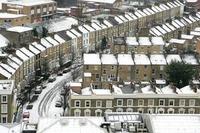Carbon footprints in the snow
 Whilst snow is creating havoc across the country, the extreme weather can be a useful tool to establish how energy efficient your home is.
Whilst snow is creating havoc across the country, the extreme weather can be a useful tool to establish how energy efficient your home is. According to B&Q, if there is no snow on your roof, it means your home is not energy efficient. The rate the snow on your property melts is affected by how much heat your house is emitting. If the snow is disappearing quicker than your neighbours, you can be certain your home is leaking both energy and money.
UK homes account for nearly one third of the countries carbon emissions, with the average household creating six tonnes of carbon dioxide a year. Understanding the efficiency of your home is an important first step to help you reduce your carbon footprint.
Installing insulation is one of the most effective ways to reduce your home’s carbon emissions, and lower your energy bill. Without proper insulation, as much as 50% of your heating could be disappearing through your walls and roof. If every UK household fitted loft insulation to a thickness of 270mm[1], it would save enough energy to heat 1.2million homes.
B&Q spokesperson, Paul Ellis, advises: ‘The snow test is an easy way of measuring how environmentally efficient your home is; something which can normally be quite tricky to do. The basic principle is simple, the more heat that escapes from your house, the quicker the snow melts. At B&Q, we have just launched a new range of insulation products which are quick and easy to install, but will still have a big impact on your home’s efficiency.’

